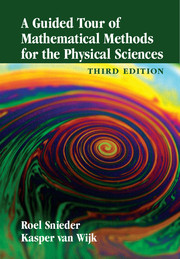Book contents
- Frontmatter
- Contents
- List of figures
- List of tables
- About the authors
- 1 Introduction
- 2 Dimensional analysis
- 3 Power series
- 4 Spherical and cylindrical coordinates
- 5 Gradient
- 6 Divergence of a vector field
- 7 Curl of a vector field
- 8 Theorem of Gauss
- 9 Theorem of Stokes
- 10 The Laplacian
- 11 Scale analysis
- 12 Linear algebra
- 13 Dirac delta function
- 14 Fourier analysis
- 15 Analytic functions
- 16 Complex integration
- 17 Green's functions: principles
- 18 Green's functions: examples
- 19 Normal modes
- 20 Potential field theory
- 21 Probability and statistics
- 22 Inverse problems
- 23 Perturbation theory
- 24 Asymptotic evaluation of integrals
- 25 Conservation laws
- 26 Cartesian tensors
- 27 Variational calculus
- 28 Epilogue, on power and knowledge
- References
- Index
9 - Theorem of Stokes
Published online by Cambridge University Press: 05 March 2015
- Frontmatter
- Contents
- List of figures
- List of tables
- About the authors
- 1 Introduction
- 2 Dimensional analysis
- 3 Power series
- 4 Spherical and cylindrical coordinates
- 5 Gradient
- 6 Divergence of a vector field
- 7 Curl of a vector field
- 8 Theorem of Gauss
- 9 Theorem of Stokes
- 10 The Laplacian
- 11 Scale analysis
- 12 Linear algebra
- 13 Dirac delta function
- 14 Fourier analysis
- 15 Analytic functions
- 16 Complex integration
- 17 Green's functions: principles
- 18 Green's functions: examples
- 19 Normal modes
- 20 Potential field theory
- 21 Probability and statistics
- 22 Inverse problems
- 23 Perturbation theory
- 24 Asymptotic evaluation of integrals
- 25 Conservation laws
- 26 Cartesian tensors
- 27 Variational calculus
- 28 Epilogue, on power and knowledge
- References
- Index
Summary
In Chapter 8 we learned that in order to find the gravitational field of a mass we have to integrate the field equation (6.45) over the mass. Gauss’ theorem can then be used to compute the integral of the divergence of the gravitational field. For the curl the situation is similar. In Section 7.5 we computed the magnetic field generated by a current in a straight infinite wire. The field equation
∇ × B = μ0J,
was used to compute the field away from the wire. However, the solution (7.13) contained an unknown constant A. The reason for this is that the field equation (7.12) was only used outside the wire, where J = 0. The treatment of Section 7.5 therefore did not provide us with the relation between the field B and its source J. The only way to obtain this relation is to integrate the field equation. This implies we have to compute the integral of the curl of a vector field. The theorem of Stokes tells us how to do this.
9.1 Statement of Stokes’ theorem
The theorem of Stokes is based on the principle that the curl of a vector field is the closed line integral of the vector field per unit surface area, as described in Section 7.1. Mathematically this statement is expressed by (7.2), which we write in a slightly different form as:
∲dSv · dr = (∇ × v) · ndS = (∇ × v) · dS.
The only difference with (7.2) is that in the above expression we have not aligned the z-axis with the vector ∇ × v. The infinitesimal surface is therefore not necessarily confined to the (x, y)-plane and the z-component of the curl is replaced by the component of the curl normal to the surface; hence, the occurrence of the terms ndS in (9.1).
Information
- Type
- Chapter
- Information
- A Guided Tour of Mathematical Methods for the Physical Sciences , pp. 108 - 124Publisher: Cambridge University PressPrint publication year: 2015
